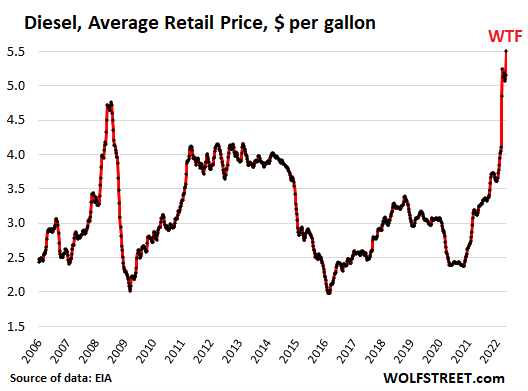

Author: Kent Moors, Ph.D.
I have just completed a major (and expensive) exercise with my proprietary Σ Algorithm trading system. As I advised Sigma Trader and PRISM Profits subscribers in Friday’s weekly portfolio reviews, the weekend was devoted to the largest series of calculations I have ever done.
It involved all 659 stocks comprising the 29 runs in the trading scheme, produced more than 25 billion lines of figures, and took more than 14 hours to complete (even with my high speed self-cooled computer system and cloud backup). It also likely spiked my electricity bill by mid-four digits. If there are trends coming on what positions will lead the recovery from the market bloodbath underway, I intend to find them early.
The first target list has been uncovered and initial picks will be moving out to subscribers shortly. However, in the course of completing this massive exercise, something else has come up. It is likely to have a pronounced impact. And it is a matter I have discussed before.
This is the time of year when storage is addressed for those fuels needed during the winter months, especially in the northern sections of the US. And while that may initially prompt concerns over the adequate supply of heating fuel, the real problem is over something else.
Diesel.
Both heating fuel and diesel are drawn from the same refinery cut and are usually regarded as having the same distillate pricing range. However, their availabilities do not have the same market impact.
In addition to its usage in transport, diesel has other vital positions. It is essential for crop cycles and a wide range of industrial uses essential to economic development. It also has a direct effect on the pricing of something else– more to the point when winter approaches – Propane.
Now propane comes from both natural gas and oil product refining but has a close pricing and availability dynamic to diesel. It is also the primary source for heat and related applications in rural America.
We are once again hearing anxiety over diesel and propane shortages once the weather turns colder. Already stockpiles are well below average levels for this time of the year. But what is providing even more disquiet among fuel traders is what the current combination of geopolitical crisis (read what Russia’s invasion of Ukraine is doing to the global oil product markets), inflation, rising disconcert over economic stagnation, and distribution of production at refineries is doing to prices.
Now this may also have a knock on effect for heating oil, given that both heating oil and diesel are taken from the same cut of a refinery run. However, at the moment, the attention is on diesel prices as dramatically seen in this graph. The raw numbers are from the US Energy Information Administration (EIA), while the forward projection results from forecasting conducted by Wolfstreet:


This reflects trends emerging elsewhere, especially in Europe, where analysts are now projecting that the combination of sanctions against Russian oil product exports and economies emerging from a post-pandemic shutdown has both depleted stockpiles and spiked prices in advance of the main season for fuel purchases. There is some anecdotal evidence that the problem is beginning to extend into gasoline availability, at least on the Continent, as refiners begin the annual process of moving from gasoline to middle distillates (i.e., heating oil and diesel, along with the gasoil product classification used elsewhere in the world)
The problem is spreading. As Reuters reported on Thursday, refinery capacity to produce sufficient middle distillates has been exceeded and inventories severely depleted across Europe, Asia, and North America. The report provided the following:
- Europe’s distillate stocks fell to 378 million barrels at the end of April, the lowest seasonal level since 2008 immediately before the onset of the recession and financial crisis.
- Singapore’s distillate stocks fell to 6 million barrels in the first week of May, the lowest seasonal level since 2006.
- US distillate fuel oil inventories stood at 105 million barrels last week, the lowest for the time of year since 2008.
The report concludes that the resulting shortages and soaring prices indicate that economies are running into binding capacity constraints and must enter a slower growth phase until more refining capacity can be made available.
That means at least one analysis has concluded there is little that can be done until economic recovery declines to cut demand.
That would oblige some difficult choices over what products to emphasize in both oil and natural gas distillation.
Meanwhile, the propane problem is a matter I have addressed before, with the problems I confronted in July 2019 and October 2020 again arising. This seems to be a recurring cycle, at times aggravated by specific political or security considerations.
When I earlier addressed the situation, the geopolitical element was directed toward China rather than Russia. But it nonetheless has a “déjà vu all over again” written across it.
What I said earlier is coming back, with the result of a Chinese tiff still in play today, providing some additional supercharging to the aftermath of what is happening in Ukraine.
I wrote in 2020:
It seems that some of the same energy concerns recur on a regular basis. About this time last year, I wrote about the continuing problem of an adequate propane supply as rural America moved toward stocking for the winter.
Well, a similar situation is rearing its head again. The normal propane cycle is also complicated by geopolitics. Propane is the main source of rural energy but it is difficult this time around given the impact of Chinese tariffs on farmers compounded by floods in the Midwest (made even worse by the heavy rain following upon a record Gulf of Mexico hurricane season).
Foreign Energy Expert Predicted “Big Oil’s” Recent Surge
With the 7 triple-digit wins under his belt in 3 months, he’s now showcasing the technology he used to do it.
Click the link here to get the full details.
The floods have already made many farmers ineligible for the grants provided by Washington to compensate for lost soybean and other exports. One needed to plant a crop by a cutoff date to receive the government payment. The flooding prevented entire regions from planting in time.
A report I released last year [2019] applies with even greater urgency today.
Then I said:
While the tariffs have dominated headlines for the better part of the last five months, we haven’t really seen their economic consequences here on US soil.
Until now.
As politicians wrestle with Donald Trump’s version of “farm aid,” the tariff impact on America’s deep red heartland now has a direct impact on the energy sector.
The White House has advanced a $12 billion aid package for farmers impacted by Chinese counter tariffs against American soybean, pork, and other agricultural products. This indicates a huge reversal of fortune for the workers that Trump claimed he would protect on the campaign trail.
The furor was instantaneous, with criticism uncharacteristically coming from both sides of the aisle. The problem stems from a huge cut in US exports after farmers have already planted and harvested with the expected major foreign sales now suspect.
As you can imagine, their economic prospects have gone from bad to worse. But the consequences of the tariffs go much deeper than the farm soil.
In fact, at this rate, the tariffs could harm one of the world’s most overlooked – yet crucial – energy products…
The tit-for-tat initiated when Trump placed tariffs on imported Chinese solar panels, steel, and aluminum, prompted China to respond with measures directed at Trump’s agrarian political base.
Soybean prices have since plummeted to 10-year lows, leaving wide areas of rural America facing farm collapse.
In response, Trump’s aid to beleaguered farmers deals with some of the immediate problem but does nothing about the potential for a spiraling trade war that could decimate middle America.
On the other side, China remains a primary global importer of soybeans, used among other things for essential animal feed.
But Beijing has access to ample alternative supplies from Argentina, Brazil, India, and even Russia. In fact, Russians are witnessing a significant rise in soybean prices for the first time in years thanks to the transition in Chinese buying patterns.
Meanwhile, back in the US, the farm belt is facing a quadruple whammy.
In addition to the plunging commodity prices and export cuts, other tariffs raising the cost of steel and aluminum will add to the expense of replacing farm equipment.
Preliminary reads put the addition to the price tag of a tractor at about 8 percent; harvesters and high-end cultivators at 10 percent.
The fourth, however, to receive a price hike is both the most pervasive and is directly connected to the energy sector.
I’m talking about propane.
The uncertainty surrounding crop prices and farm prospects has certainly had a negative impact on the propane market.
You may think weekend barbecues when the subject of propane arises. But the gas is a main factor in crop drying, for a range of uses in pumping, generation, refrigeration, and thermal agriculture (protecting crops from damaging cold).
Besides its utility in maintaining crops, the biggest connection between propane and farm life can be found at home. Well over 50 percent of rural Americans use propane to heat their houses and other out structures.
And that’s what makes the aftermath of the agricultural tariff hit so tricky…
Facing collapsing commodity prices, farmers have found themselves quickly in a classic “rock and hard place” scenario.
They depend on the proceeds of sales to pay for this season and prepare for the next. This year, though, nobody has a firm grip on where matters are heading.
A handout in the form of a subsidy from Washington is not what anybody in this part of the country had in mind.
In such an environment, it has become difficult to estimate how much propane is going to be needed. Much of the amount required for the end of the harvest season is already in the system. But it is the likely demand (and, more importantly, prices) that remains a factor in the fourth quarter.
Normally, rural areas have locked in propane consignments by this time in the year. The trick has always been to estimate what is required to avoid having to acquire additional volume in the colder months when prices are always much higher. In addition, propane will be essential in the next growing season and that should be on hand when the sowing starts.
This year, prices have been drifting lower than average, prompting many end users to delay the usual moves.
However, recently, propane has begun to spike. Without having a clear idea what the market for their product is going to be down the road, entire farming communities have seen some unusual posturing.
Several state agencies are now warning farmers not to wait as prices advance. A run is expected, merely exacerbating the situation. Some regions like New England, often the usual suspect, may experience spot shortages with others forced to weather pipeline and storage problems.
But the difficulties hardly stop there. Problems are rapidly moving back in the supply chain to midstream, and even upstream.
Propane is a byproduct of both natural gas processing and crude oil refining. Unfortunately, having no clear idea what the product distribution should be – because the propane cut is unknown – means there are likely to be significant imbalances in the refining of market products resulting.
More disturbing is the even further upstream impact resulting from a “fuzzy” propane demand expectation. The longer it lasts, the more difficult it will be for operating companies to determine how much gas extraction makes sense.
This begins with US engendering a foreign response that adversely impacts US farmers. But it is morphing into a much broader concern.
Hopefully the bad news doesn’t get much worse, but in this energy and political climate, it’s anyone’s guess.
Since I wrote the above comments, the propane marker cratered even more, with exports from US refineries to foreign locations other than China rising to new aggregate highs while supply for domestic consumption has moved down.
In addition, attempts to improve propane and related LPG (liquid petroleum gas) transit in the Northeast – traditionally the region having the most pronounced distribution problems – have slowed. Not having a firm grasp on the propane demand, capital investments in the network have become more problematic.
A winter colder than average will once again put a strain on the delivery system and spike spot prices for any additional consignments that farmers need to buy.
I have been following developments with the diesel market and among primary propane distributors to identify early signal of investment plays. My Sigma Trader and PRISM Profits members will be the first to benefit.


Dr. Kent Moors
This is an installment of Classified Intelligence Brief, your guide to what’s really happening behind the headlines… and how to profit from it. Dr. Kent Moors served the United States for 30 years as one of the most highly decorated intelligence operatives alive today (including THREE Presidential commendations).
After moving through the inner circles of royalty, oligarchs, billionaires, and the uber-rich, he discovered some of the most important secrets regarding finance, geo-politics, and business. As a result, he built one of the most impressive rolodexes in the world. His insights and network of contacts took him from a Vietnam veteran to becoming one of the globe’s most sought after consultants, with clients including six of the largest energy companies and the United States government.
Now, Dr. Moors is sharing his proprietary research every week…knowledge filtered through his decades as an internationally recognized professor and scholar, intelligence operative, business consultant, investor, and geo-political “troubleshooter.” This publication is designed to give you an insider’s view of what is really happening on the geo-political stage.
You can sign up for FREE to Classified Intelligence Brief and begin receiving insights from Dr. Moors and his team immediately.
Just click here – https://classifiedintelligencebrief.com/








